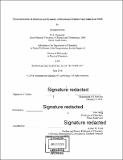Characterization of structure and dynamics of membrane proteins from solid-state NMR
Author(s)
Kwon, Byungsu
DownloadFull printable version (19.70Mb)
Other Contributors
Massachusetts Institute of Technology. Department of Chemistry.
Advisor
Mei Hong.
Terms of use
Metadata
Show full item recordAbstract
Solid-state nuclear magnetic resonance (ssNMR) spectroscopy is an essential tool for elucidating the structure, dynamics, and function of biomolecules. ssNMR is capable of studying membrane proteins in near-native lipid bilayers and is thus preferred over other biophysical techniques for characterizing the structure and dynamics of membrane proteins. This thesis primarily focuses on the study of the following membrane proteins: 1) the N-terminal ectodomain and C-terminal cytoplasmic domain of influenza A virus M2 and 2) HIV-1 glycoprotein gp4l membrane-proximal external region and transmembrane domain (MPER-TMD) in a near native membrane environment. The cytoplasmic domain of M2 is necessary for membrane scission and virus shedding. The M2(22-71) construct shows random-coil chemical shifts, large motional amplitudes, and a membrane surface-bound location with close proximity to water, indicating the post-amphipathic helix (AH) cytoplasmic domain is a dynamic random coil near the membrane surface. The influenza M2 ectodomain contains highly conserved epitopes but its structure is largely unknown. The M2(1-49) construct containing both the ectodomain and transmembrane domain exhibits an entirely unstructured ectodomain with a motional gradient in which the motion is slower for residues near the TM domain, which attributed to the formation of a tighter helical bundle in the presence of drug that should cause the more tightened C-terminal ectodomain, thereby slowing its local motions. HIV-1 virus gp4l is directly involved in virus-cell membrane fusion. However, the structural topologies of the gp4l MPER-TMD are still controversial and the biologically-relevant intrinsic conformational state of MPER has not yet been determined. In order to obtain near native structural information of gp4l, we have studied gp41 (665-704) and found a primarily a-helical conformation, membrane-anchored trimeric TMD and water-exposed membrane surface-bound MPER. Intra- and intermolecular distances measured using ¹⁹C-¹⁹F REDOR and ¹⁹F-¹⁹F CODEX revealed that MPER-TMD has a significant kink between MPER and TMD, which has aided a deeper understanding of the HIV virus entry mechanism and the design of vaccines.
Description
Thesis: Ph. D. in Physical Chemistry, Massachusetts Institute of Technology, Department of Chemistry, 2018. Cataloged from PDF version of thesis. Includes bibliographical references.
Date issued
2018Department
Massachusetts Institute of Technology. Department of ChemistryPublisher
Massachusetts Institute of Technology
Keywords
Chemistry.